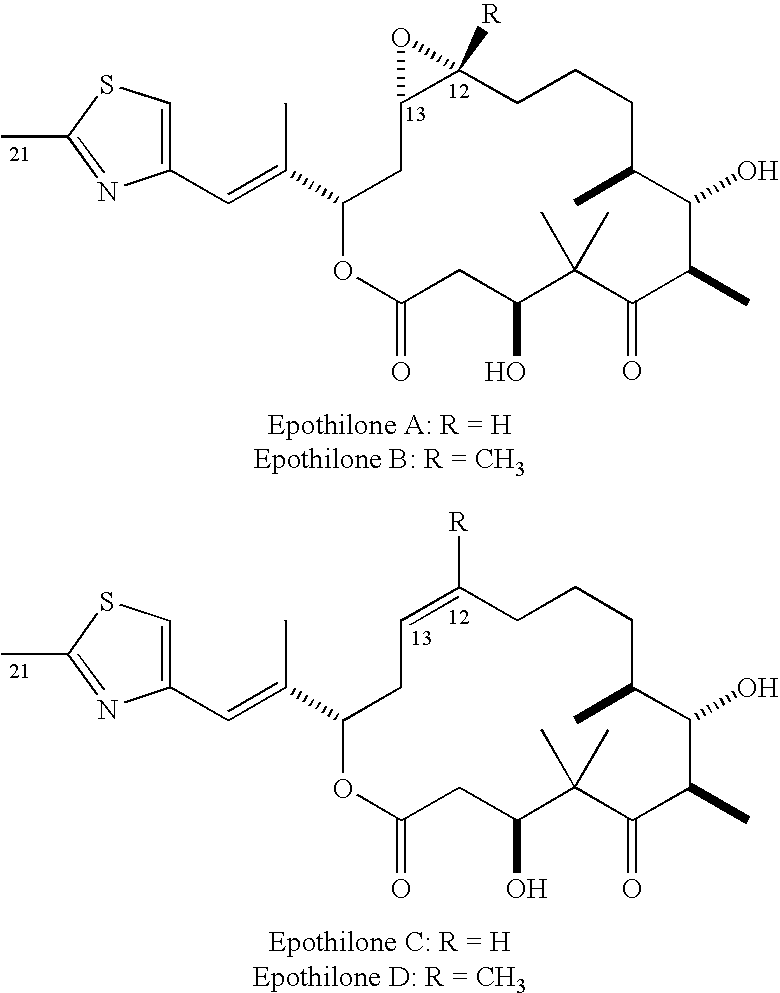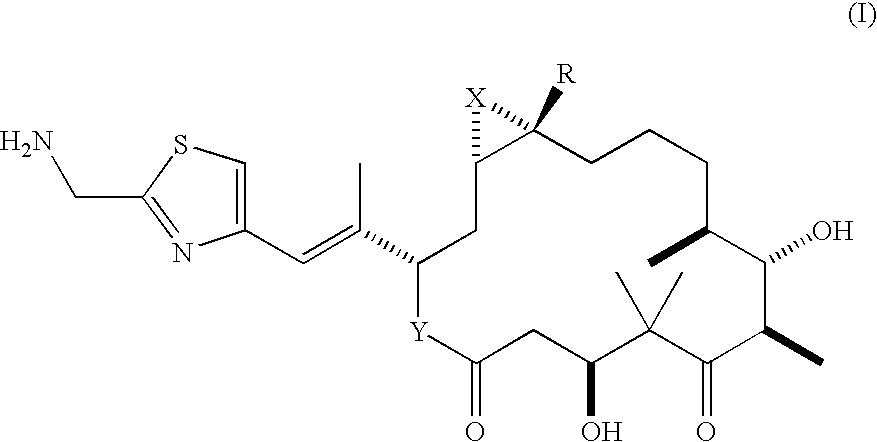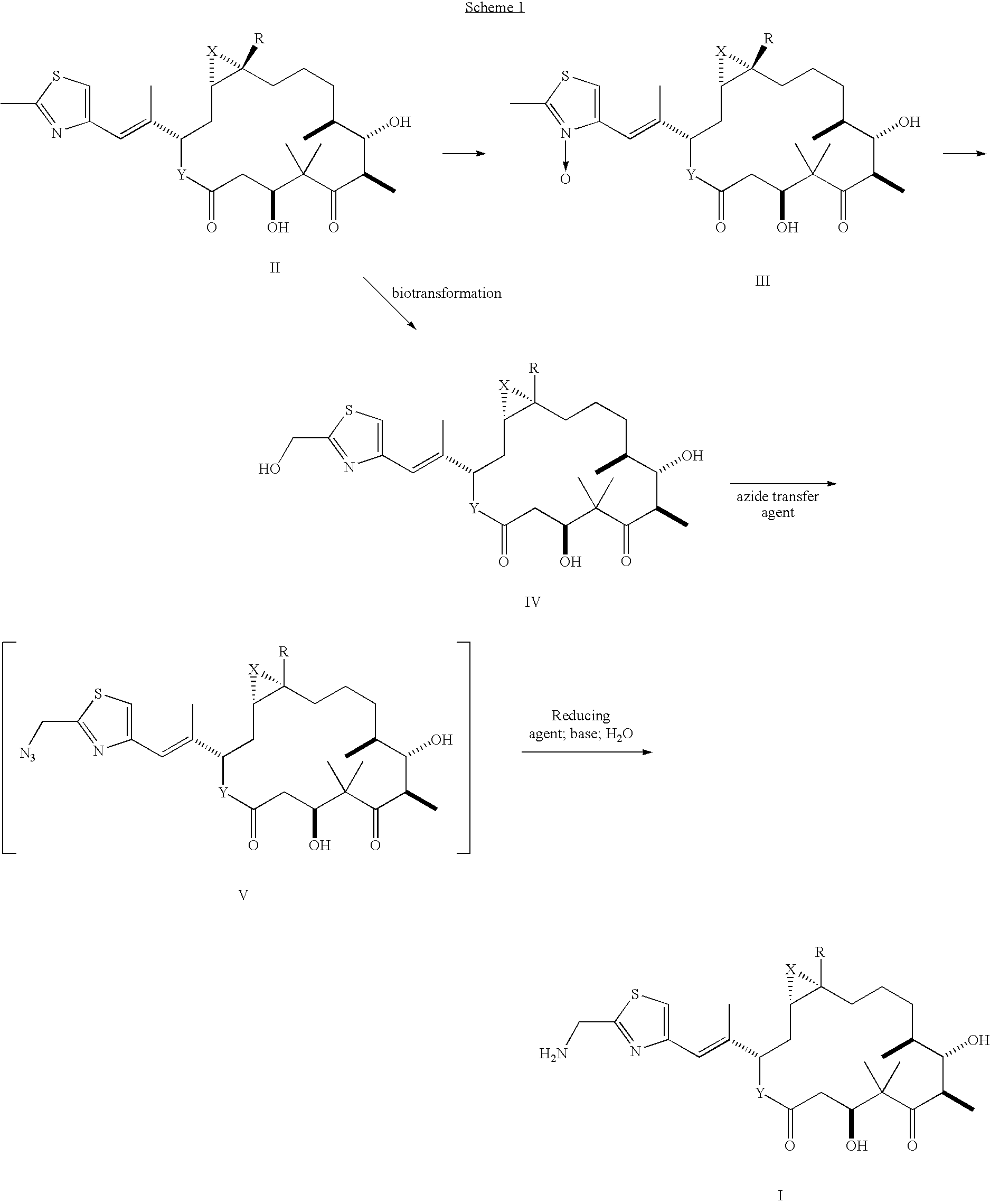Method of preparation of 21-amino epothilone derivatives
- Summary
- Abstract
- Description
- Claims
- Application Information
AI Technical Summary
Problems solved by technology
Method used
Image
Examples
example 1
[0024]Epothilone B (1.98 g, 3.90 mmol) was placed under argon and dissolved in 60 ml dry CH2Cl2. To this solution was added mCPBA (0.720 g, 4.17 mmol, 1.07 equivalents). The mixture was stirred at 25° C. for 5.5 hours. The reaction mixture was quenched with NaHCO3 (60 ml), and extracted with CHCl3 (3×75 ml). The organic phase was washed with water (100 ml) followed by 5% Na2SO3 (aq., 70 ml) and then brine (70 ml). The organic phase was then dried over Na2SO4. The crude reaction product was chromatographed using silica gel and eluted with 2% MeOH in CHCl3 to yield the N-oxide (0.976 g, 48% yield) as a white solid.
[0025](ii) To a resealable tube under argon was added the N-oxide (0.976 g, 1.86 mmol) dissolved in dry CH2Cl2 (35 ml), 2,6-lutidine (1.73 ml, 14.88 mmol, 8 equivalents) and (CF3CO)2O (1.84 ml, 13.02 mmol, 7 equivalents). The tube was sealed and heated at 70° C. for 25 min. The mixture was allowed to cool and the solvent was removed under a stream of argon, followed by conce...
example 2
[0026]Epothilone B (5.08 g, 10.0 mmol) was placed under argon and dissolved in dry CH2Cl2 (150 ml). To this solution was added powdered NaHCO3 (2.11 g, 25.0 mmol, 2.5 equivalents) and purified mCPBA (4.31 g, 25.0 mmol, 2.5 equivalents). The mixture was stirred at 25° C. for 6 hours. The reaction mixture was washed with water (100 ml) followed by 5% Na2SO3 (aq., 70 ml) and then brine (70 ml), and the organic phase was dried over Na2SO4. The crude reaction product was chromatographed on silica gel, eluting with 20-30% EtOAc / 2% Et3N / CH2Cl2, to afford the N-oxide (1.93 g., 36.8% yield) as a white fluffy solid. Larger-scale runs, employing 15 and 19 g of starting material, provided N-oxide epothilone B in yields of 39 and 32%, respectively.
[0027]The N-oxide (1.89 g, 3.60 mmol) was dissolved in dry CH2Cl2 (100 ml), 2,6-lutidine (3.15 ml, 27 mmol, 7.5 equivalents) and (CF3CO)2O (1.78 ml, 12.6 mmol, 3.5 equivalents). The mixture was stirred at 25° C. for 3 hours, then diluted with EtOH (60 ...
example 4
Preparation and Isolation of [1S-[1R*,3R*(E),7R*,10S*,11R*,12R*,16S*]]-3-[2-[2-(Azidomethyl)-4-thiazolyl]-1-methylethenyl]-7,11-dihydroxy-8,8,10,12,16-pentamethyl-4,17-dioxabicyclo[14.1.0]heptadecane-5,9-dione
[0030]To a stirred solution of epothilone F (5 g, 9.55 mmol) in tetrahydrofuran (40.0 ml) at room temperature was added diphenylphosphoryl azide (2.28 ml, 2.89 g, 10.5 mmol, 1.1 equivalents). The mixture was stirred for approximately 5 min. 1,8-Diazabicyclo[5.4.0]undec-7-ene (1.72 ml, 1.74 g, 11.46 mmol, 1.2 equivalents) was then added. The mixture was heated to 40° C. and stirred for 3 hours. The reaction mixture was cooled to room temperature and diluted with ethyl acetate (160 ml), followed by washing with H2O (25 ml). The organic layer was washed with 10% aqueous NH4OH (25 ml), followed by 1M NH4OH (25 ml). The combined aqueous layers were extracted with EtOAc (20 ml). The combined organic layers were washed with 15% aqueous NaH2PO4 (20 ml), dried over Na2SO4, and concentra...
PUM
| Property | Measurement | Unit |
|---|---|---|
| Crystallization enthalpy | aaaaa | aaaaa |
Abstract
Description
Claims
Application Information
 Login to view more
Login to view more - R&D Engineer
- R&D Manager
- IP Professional
- Industry Leading Data Capabilities
- Powerful AI technology
- Patent DNA Extraction
Browse by: Latest US Patents, China's latest patents, Technical Efficacy Thesaurus, Application Domain, Technology Topic.
© 2024 PatSnap. All rights reserved.Legal|Privacy policy|Modern Slavery Act Transparency Statement|Sitemap



